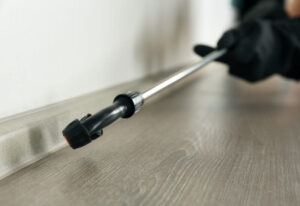What’s the difference between pest control and pest prevention?

When you hear the terms pest control and pest prevention, do they seem like they’re referencing the same thing? In fact, they are very different approaches to keeping homes and businesses free from invading pests. While pest control addresses an existing problem, preventative pest control does exactly what it says it does: prevent pest infestation. Pest prevention requires the cooperation of the pest control professional and the client, to keep pests off the property.
Traditional pest control begins when a pest is observed in a building. The home or business owner calls the pest control company, which springs into action with a plan to eradicate pests from the property. This reactionary process involves measures like the application of pesticides and the deploying of pest control equipment. How does it differ from pest prevention? Pest prevention, rather than being a reaction, is a proactive approach, working to keep pests from ever entering the building in the first place. It’s a comprehensive approach, looking at the overall picture and crafting a plan that involves good sanitation practices, exclusion, landscaping, and cultural practices that discourage pests from encroaching on the property. It’s an effective approach and one that is typically more environmentally friendly than pest control. Why? Because instead of focusing on chemicals that kill bugs, it focuses on best practices for preventing them from taking up residence.
Typical pest prevention measures include:
- Vigilance in checking for signs of pests.
- Cleaning practices that don’t invite pests.
- Taking care not to accidentally bring pests into the building.
- Staying on top of maintenance tasks.
- Keeping garbage receptacles away from the building and cleaning them regularly.
- Sealing off possible entry points for pests.
- Schedule regular inspections and monitoring for pests.
- Landscaping in a way that helps limit pest intrusion.
- Communicating clearly about pest prevention strategies.
In a commercial facility, a comprehensive approach to pest prevention includes clear communication and making sure all employees understand the strategies that are in place. Assigning the task of monitoring the facility and incoming shipments for signs of pests, determining which areas need to be dry washed instead of wet washed to prevent moisture seeking pests like cockroaches and flies, and establishing uniform cleaning practices that will prevent employees from inadvertently bringing pests into the facility are all important facets of a pest prevention plan. It’s also vital to make sure that maintenance tasks are completed in a timely fashion and regular wellness checks are established to make sure the program is working.
In a home, the same principles apply but are obviously executed somewhat differently. Cleaning regularly, particularly keeping kitchen and bathroom areas scrupulously clean, is a big step in preventing infestations, as is keeping garbage in a sealed trash bin and disposing of it regularly. Fixing water leaks promptly is important, and standing water should not be allowed to remain on the property. Any used furniture that comes into the house should first be thoroughly inspected for pests, and gutters should be cleaned regularly to keep them from becoming an inviting home for pests. Grass should be cut low, vegetation trimmed away from the house, and any cracks or crevices should be filled with silicone-based caulk. There should be screens on windows, attic vents, and chimney openings, and these screens must be kept in good repair. Pet food should be stored in a sealed plastic container, and pet bowls must be kept clean. Everyone who lives in the home needs to be educated about pest prevention, because only a complete buy-in from everyone involved will effectively keep pests out.
Of course, even the best pest prevention is sometimes not enough to completely eradicate pests from a property. When specific needs arise that require pest control, it’s important to partner with a pest control company that will properly analyze the property and suggest modifications to the pest prevention plan, as well as designing a strategy for pest control. Pest management is often best achieved using strategies that incorporate both pest prevention and pest control measures.
For a comprehensive pest control and pest prevention plan to protect your home or business, call the professionals at All Star Pest Management. The exterminator Baltimore area residents have trusted for more than a decade, we’re a family-owned and operated business providing customized solutions to deal with any pest problem you’re facing. The team at All Star Pest Management respects the home of every client, and they’ll treat your infestation conveniently and effectively while treating your home or business as if it were their own. To make an appointment, call 410-772-0204 in Catonsville or 410-772-0204 in Columbia or request a free estimate through our website.
